
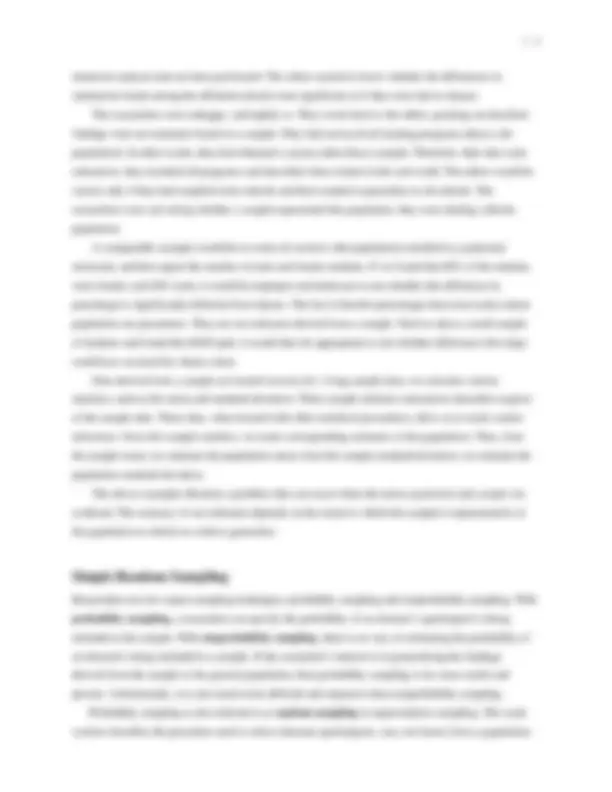
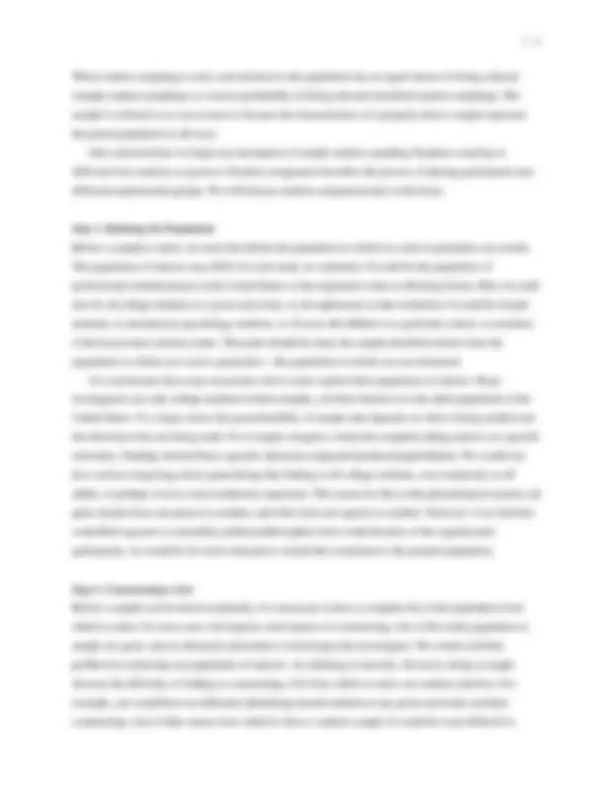
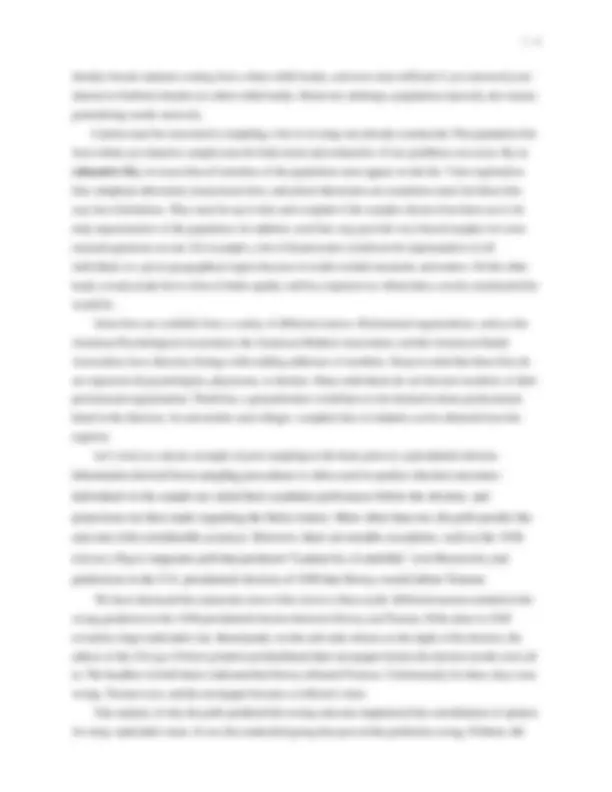
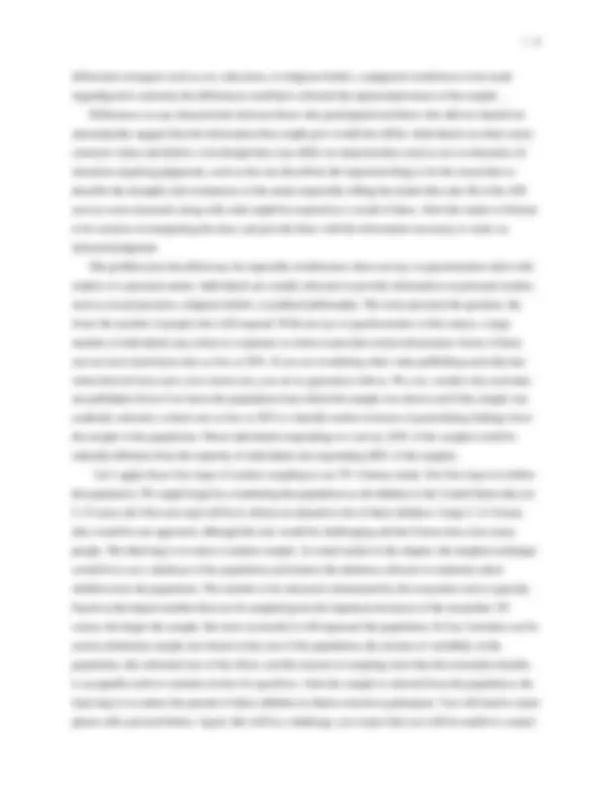
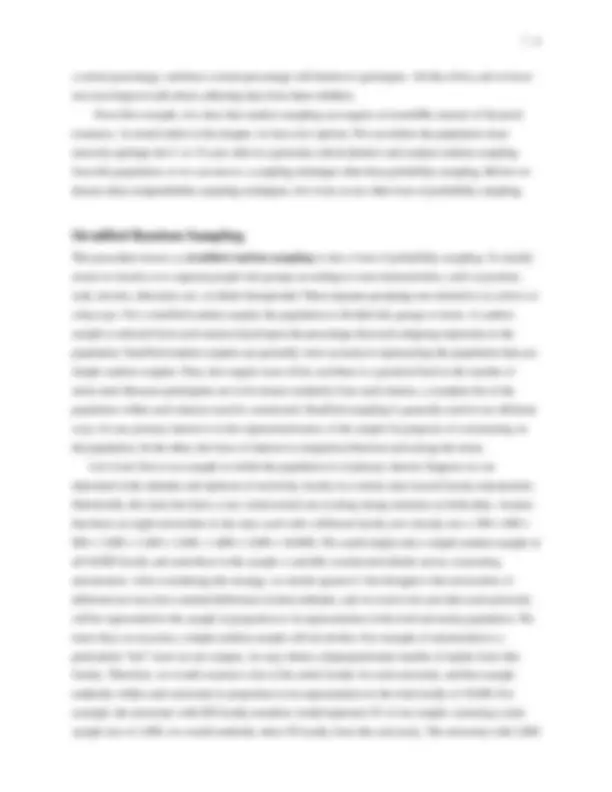
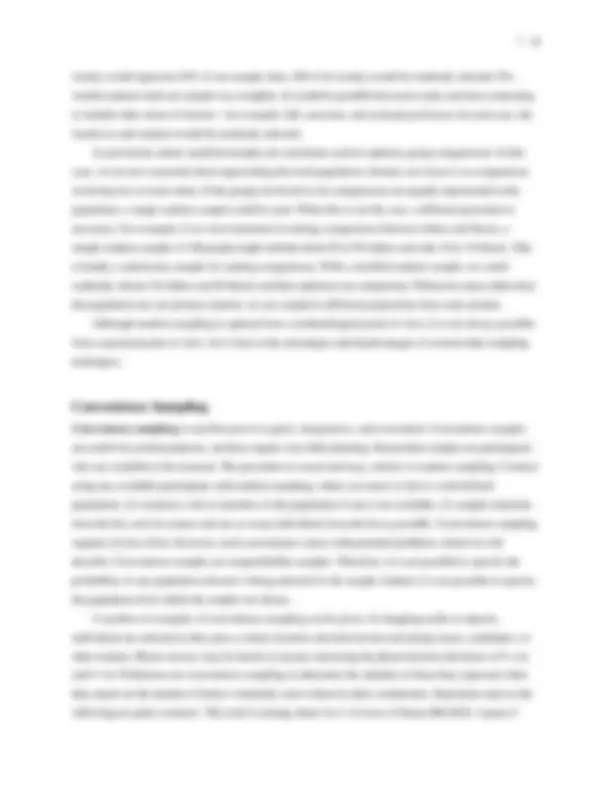
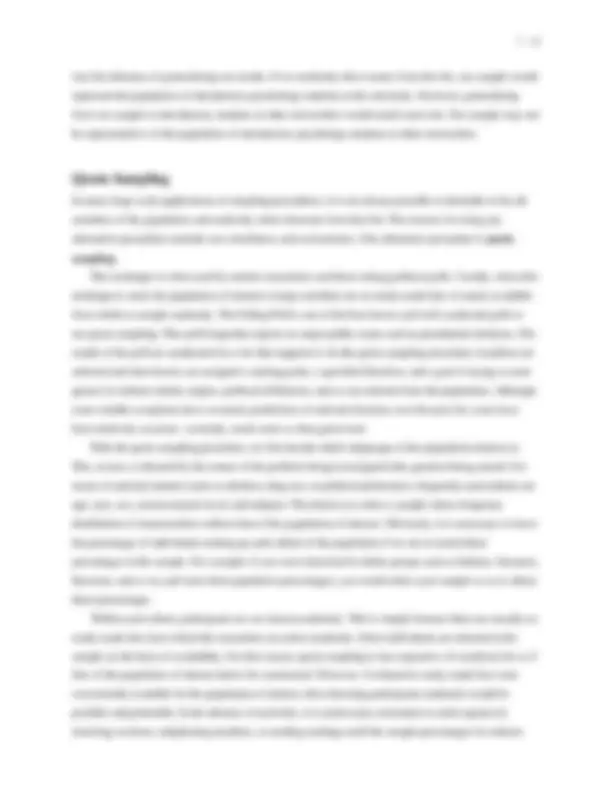

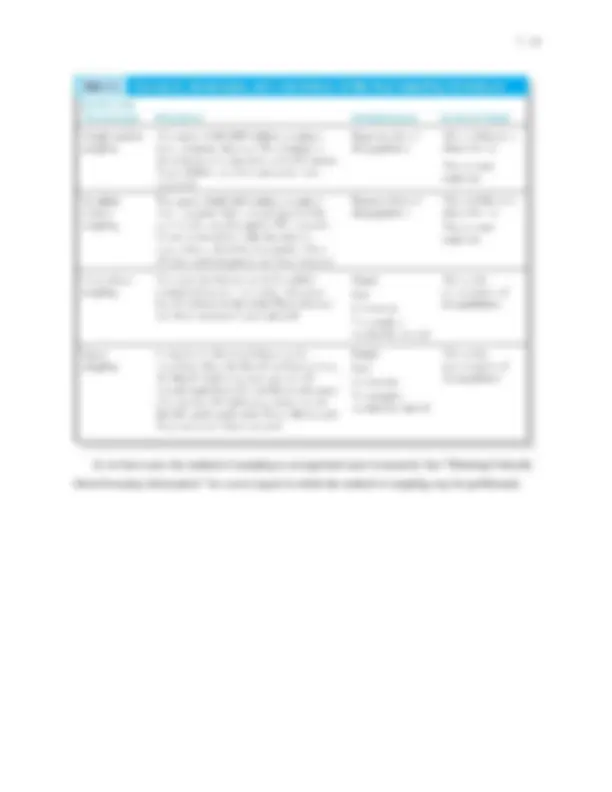
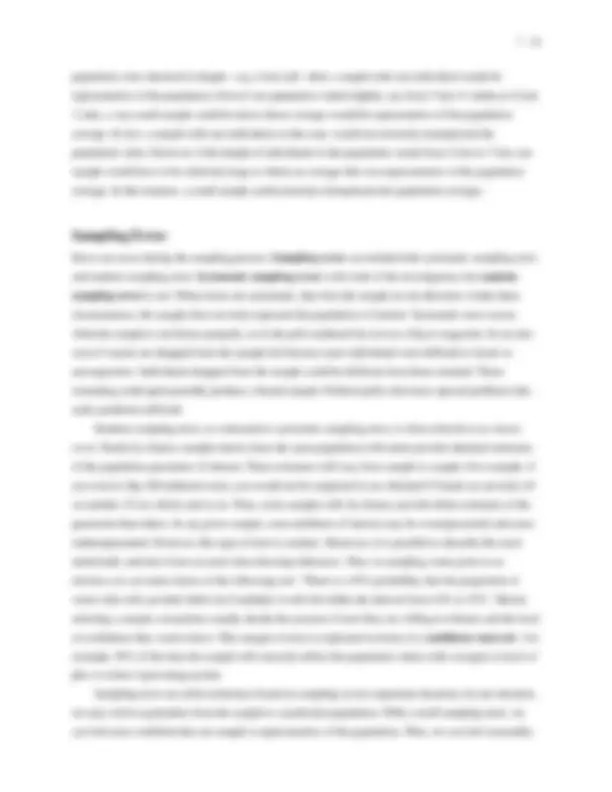
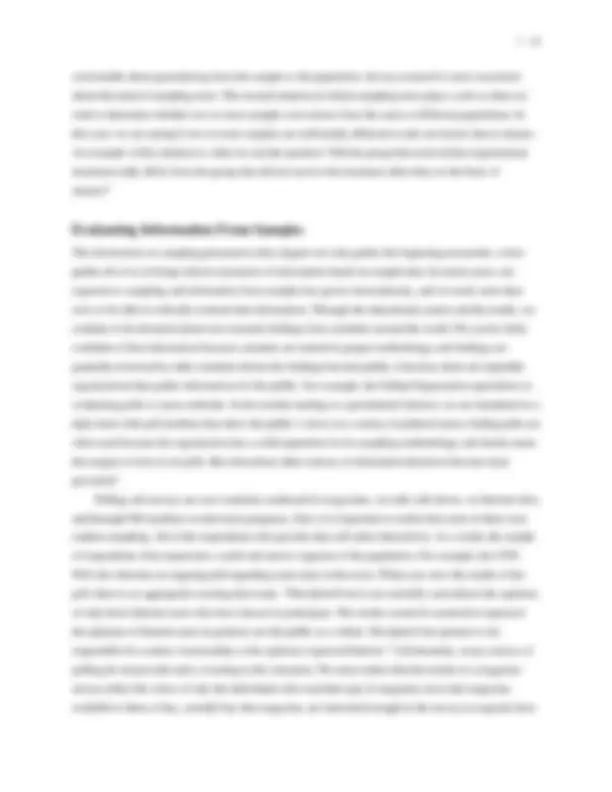
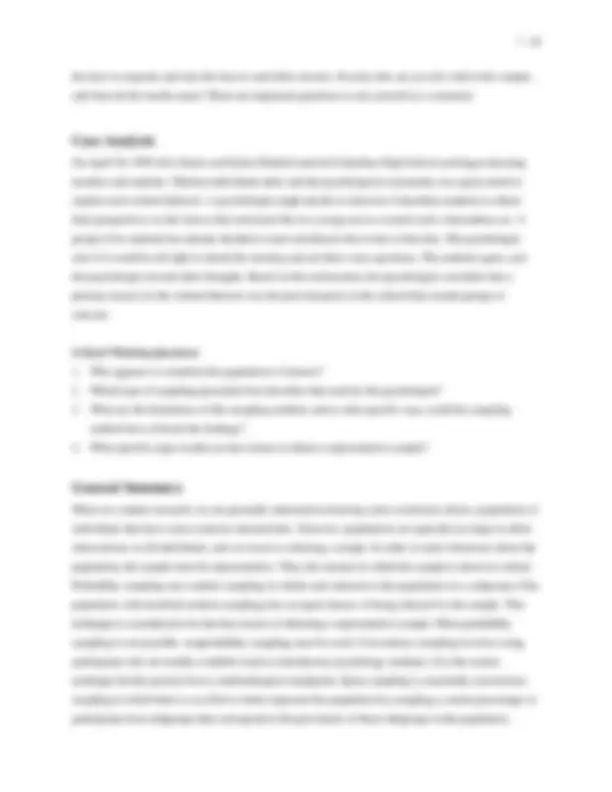
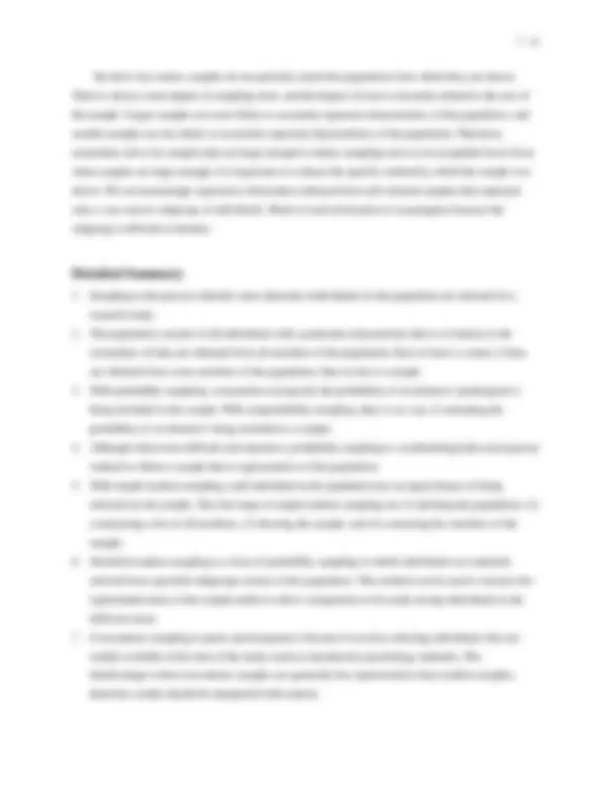
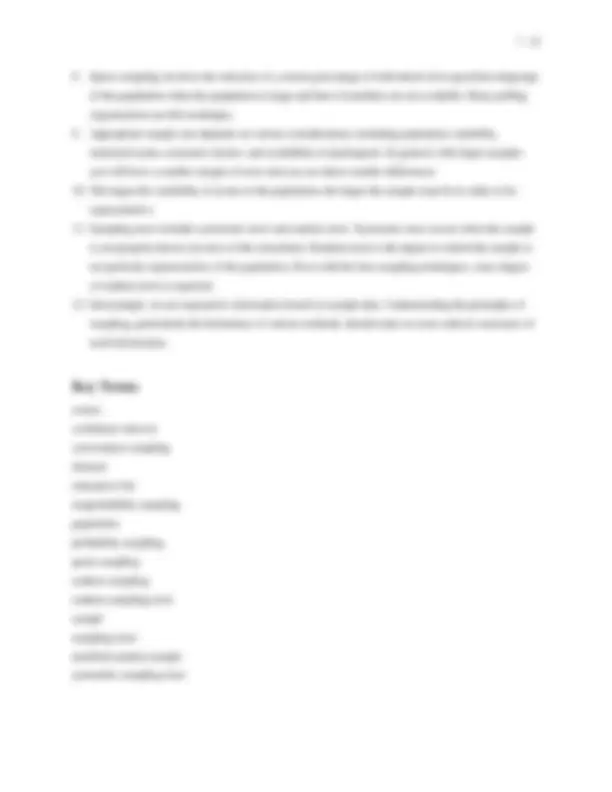
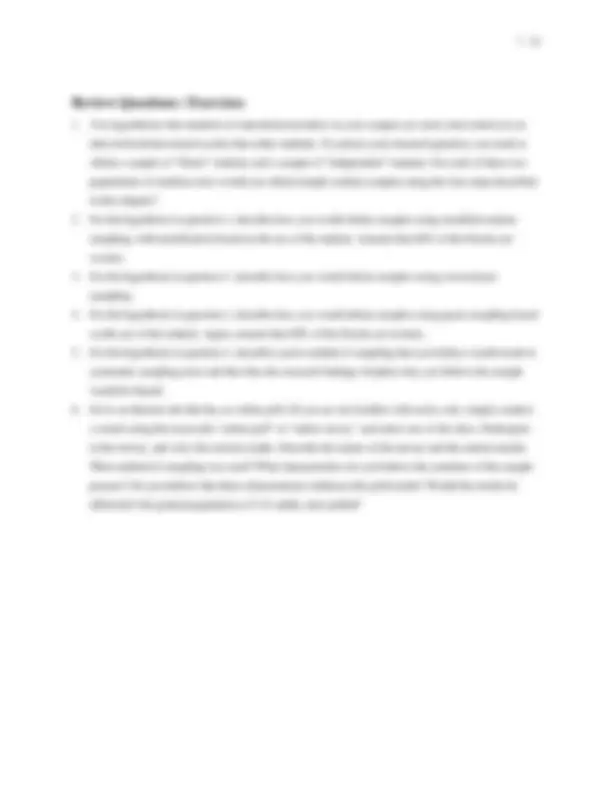


Study with the several resources on Docsity

Earn points by helping other students or get them with a premium plan


Prepare for your exams
Study with the several resources on Docsity

Earn points to download
Earn points by helping other students or get them with a premium plan
Community
Ask the community for help and clear up your study doubts
Discover the best universities in your country according to Docsity users
Free resources
Download our free guides on studying techniques, anxiety management strategies, and thesis advice from Docsity tutors
sampling and techniques to study materials
Typology: Exams
1 / 23

This page cannot be seen from the preview
Don't miss anything!
















Step 1. Defining the Population Step 2. Constructing a List Step 3. Drawing the Sample Step 4. Contacting Members of the Sample
Thinking Critically About Everyday Information
The way in which we select a sample of individuals to be research participants is critical. How we select participants (random sampling) will determine the population to which we may generalize our research findings. The procedure that we use for assigning participants to different treatment conditions (random assignment) will determine whether bias exists in our treatment groups (Are the groups equal on all known and unknown factors?). We address random sampling in this chapter; we will address random assignment later in the book. If we do a poor job at the sampling stage of the research process, the integrity of the entire project is at risk. If we are interested in the effect of TV violence on children, which children are we going to observe? Where do they come from? How many? How will they be selected? These are important questions. Each of the sampling techniques described in this chapter has advantages and disadvantages.
Before describing sampling procedures, we need to define a few key terms. The term population means all members that meet a set of specifications or a specified criterion. For example, the population of the United States is defined as all people residing in the United States. The population of New Orleans means all people living within the city’s limits or boundary. A population of inanimate objects can also exist, such as all automobiles manufactured in Michigan in the year 2003. A single member of any given population is referred to as an element. When only some elements are selected from a population, we refer to that as a sample; when all elements are included, we call it a census. Let’s look at a few examples that will clarify these terms. Two research psychologists were concerned about the different kinds of training that graduate students in clinical psychology were receiving. They knew that different programs emphasized different things, but they did not know which clinical orientations were most popular. Therefore, they prepared a list of all doctoral programs in clinical psychology (in the United States) and sent each of them a questionnaire regarding aspects of their program. The response to the survey was excellent; nearly 95% of the directors of these programs returned the completed questionnaire. The researchers then began analyzing their data and also classifying schools into different clinical orientations: psychoanalytic, behavioristic, humanistic, Rogerian, and so on. When the task was complete, they reported the percentage of schools having these different orientations and described the orientations that were most popular, which were next, and so on. They also described other aspects of their data. The study was written up and submitted for publication to one of the professional journals dealing with matters of clinical psychology. The editor of the journal read the report and then returned it with a letter rejecting the manuscript for publication. In part, the letter noted that the manuscript was not publishable at this time because the proper
When random sampling is used, each element in the population has an equal chance of being selected (simple random sampling) or a known probability of being selected (stratified random sampling). The sample is referred to as representative because the characteristics of a properly drawn sample represent the parent population in all ways. One caution before we begin our description of simple random sampling: Random sampling is different from random assignment. Random assignment describes the process of placing participants into different experimental groups. We will discuss random assignment later in the book.
Step 1. Defining the Population Before a sample is taken, we must first define the population to which we want to generalize our results. The population of interest may differ for each study we undertake. It could be the population of professional football players in the United States or the registered voters in Bowling Green, Ohio. It could also be all college students at a given university, or all sophomores at that institution. It could be female students, or introductory psychology students, or 10-year-old children in a particular school, or members of the local senior citizens center. The point should be clear; the sample should be drawn from the population to which you want to generalize—the population in which you are interested. It is unfortunate that many researchers fail to make explicit their population of interest. Many investigators use only college students in their samples, yet their interest is in the adult population of the United States. To a large extent, the generalizability of sample data depends on what is being studied and the inferences that are being made. For example, imagine a study that sampled college juniors at a specific university. Findings showed that a specific chemical compound produced pupil dilation. We would not have serious misgivings about generalizing this finding to all college students, even tentatively to all adults, or perhaps even to some nonhuman organisms. The reason for this is that physiological systems are quite similar from one person to another, and often from one species to another. However, if we find that controlled exposure to unfamiliar political philosophies led to radicalization of the experimental participants, we would be far more reluctant to extend this conclusion to the general population.
Step 2. Constructing a List Before a sample can be chosen randomly, it is necessary to have a complete list of the population from which to select. In some cases, the logistics and expense of constructing a list of the entire population is simply too great, and an alternative procedure is forced upon the investigator. We could avoid this problem by restricting our population of interest—by defining it narrowly. However, doing so might increase the difficulty of finding or constructing a list from which to make our random selection. For example, you would have no difficulty identifying female students at any given university and then constructing a list of their names from which to draw a random sample. It would be more difficult to
identify female students coming from a three-child family, and even more difficult if you narrowed your interest to firstborn females in a three-child family. Moreover, defining a population narrowly also means generalizing results narrowly. Caution must be exercised in compiling a list or in using one already constructed. The population list from which you intend to sample must be both recent and exhaustive. If not, problems can occur. By an exhaustive list, we mean that all members of the population must appear on the list. Voter registration lists, telephone directories, homeowner lists, and school directories are sometimes used, but these lists may have limitations. They must be up to date and complete if the samples chosen from them are to be truly representative of the population. In addition, such lists may provide very biased samples for some research questions we ask. For example, a list of homeowners would not be representative of all individuals in a given geographical region because it would exclude transients and renters. On the other hand, a ready-made list is often of better quality and less expensive to obtain than a newly constructed list would be. Some lists are available from a variety of different sources. Professional organizations, such as the American Psychological Association, the American Medical Association, and the American Dental Association, have directory listings with mailing addresses of members. Keep in mind that these lists do not represent all psychologists, physicians, or dentists. Many individuals do not become members of their professional organizations. Therefore, a generalization would have to be limited to those professionals listed in the directory. In universities and colleges, complete lists of students can be obtained from the registrar. Let’s look at a classic example of poor sampling in the hours prior to a presidential election.
We have discussed the systematic error of the Literary Digest poll. Different reasons resulted in the wrong prediction in the 1948 presidential election between Dewey and Truman. Polls taken in 1948 revealed a large undecided vote. Based partly on this and early returns on the night of the election, the editors of the Chicago Tribune printed and distributed their newspaper before the election results were all in. The headline in bold letters indicated that Dewey defeated Truman. Unfortunately for them, they were wrong. Truman won, and the newspaper became a collector’s item. One analysis of why the polls predicted the wrong outcome emphasized the consolidation of opinion for many undecided voters. It was this undecided group that proved the prediction wrong. Pollsters did
begun, the table of random numbers dictates who will be selected. The experimenter should not alter this procedure. A more recent method of random sampling uses the special functions of computer software. Many population lists are now available as software databases (such as Excel, Quattro Pro, Lotus123) or can be imported to such a database. Many of these database programs have a function for generating a series of random numbers and a function for selecting a random sample from a range of entries in the database. We also mentioned above that numerous internet sites can generate random numbers. After you learn the particular menu selections to perform these tasks, these methods of random sampling are often the simplest.
Step 4. Contacting Members of a Sample Researchers using random sampling procedures must be prepared to encounter difficulties at several points. As we noted, the starting point is an accurate statement that identifies the population to which we want to generalize. Then we must obtain a listing of the population, accurate and up-to-date, from which to draw our sample. Further, we must decide on the random selection procedure that we wish to use. Finally, we must contact each of those selected for our sample and obtain the information needed. Failing to contact all individuals in the sample can be a problem, and the representativeness of the sample can be lost at this point. To illustrate what we mean, assume that we are interested in the attitudes of college students at your university. We have a comprehensive list of students and randomly select 100 of them for our sample. We send a survey to the 100 students, but only 80 students return it. We are faced with a dilemma. Is the sample of 80 students who participated representative? Because 20% of our sample was not located, does our sample underrepresent some views? Does it overrepresent other views? In short, can we generalize from our sample to the college population? Ideally, all individuals in a sample should be contacted. As the number contacted decreases, the risk of bias and not being representative increases. Thus, in our illustration, to generalize to the college population would be to invite risk. Yet we do have data on 80% of our sample. Is it of any value? Other than simply dropping the project or starting a new one, we can consider an alternative that other researchers have used. In preparing our report, we would first clearly acknowledge that not all members of the sample participated and therefore the sample may not be random—that is, representative of the population. Then we would make available to the reader or listener of our report the number of participants initially selected and the final number con- tacted, the number of participants cooperating, and the number not cooperating. We would attempt to assess the reason or reasons participants could not be contacted and whether differences existed between those for whom there were data and those for whom there were no data. If no obvious differences were found, we could feel a little better about the sample’s being representative. However, if any pattern of
differences emerged, such as sex, education, or religious beliefs, a judgment would have to be made regarding how seriously the differences could have affected the representativeness of the sample. Differences on any characteristic between those who participated and those who did not should not automatically suggest that the information they might give would also differ. Individuals can share many common values and beliefs, even though they may differ on characteristics such as sex or education. In situations requiring judgments, such as the one described, the important thing is for the researcher to describe the strengths and weaknesses of the study (especially telling the reader that only 80 of the 100 surveys were returned), along with what might be expected as a result of them. Alert the reader or listener to be cautious in interpreting the data, and provide them with the information necessary to make an informed judgment. The problem just described may be especially troublesome when surveys or questionnaires deal with matters of a personal nature. Individuals are usually reluctant to provide information on personal matters, such as sexual practices, religious beliefs, or political philosophy. The more personal the question, the fewer the number of people who will respond. With surveys or questionnaires of this nature, a large number of individuals may refuse to cooperate or refuse to provide certain information. Some of these surveys have had return rates as low as 20%. If you are wondering what value publishing such data has when derived from such a low return rate, you are in agreement with us. We, too, wonder why such data are published. Even if we knew the population from which the sample was drawn and if the sample was randomly selected, a return rate as low as 20% is virtually useless in terms of generalizing findings from the sample to the population. Those individuals responding to a survey (20% of the sample) could be radically different from the majority of individuals not responding (80% of the sample). Let’s apply these four steps of random sampling to our TV violence study. Our first step is to define the population. We might begin by considering the population as all children in the United States that are 5–15 years old. Our next step will be to obtain an exhaustive list of these children. Using U. S. Census data would be one approach, although the task would be challenging and the Census does miss many people. The third step is to select a random sample. As noted earlier in the chapter, the simplest technique would be to use a database of the population and instruct the database software to randomly select children from the population. The number to be selected is determined by the researcher and is typically based on the largest number that can be sampled given the logistical resources of the researcher. Of course, the larger the sample, the more accurately it will represent the population. In fact, formulas can be used to determine sample size based on the size of the population, the amount of variability in the population, the estimated size of the effect, and the amount of sampling error that the researcher decides is acceptable (refer to statistics books for specifics). After the sample is selected from the population, the final step is to contact the parents of these children to obtain consent to participate. You will need to make phone calls and send letters. Again, this will be a challenge; you expect that you will be unable to contact
faculty would represent 20% of our sample; thus, 200 of its faculty would be randomly selected. We would continue until our sample was complete. It would be possible but more costly and time consuming to include other strata of interest—for example, full, associate, and assistant professors. In each case, the faculty in each stratum would be randomly selected. As previously noted, stratified samples are sometimes used to optimize group comparisons. In this case, we are not concerned about representing the total population. Instead, our focus is on comparisons involving two or more strata. If the groups involved in our comparisons are equally represented in the population, a single random sample could be used. When this is not the case, a different procedure is necessary. For example, if we were interested in making comparisons between whites and blacks, a simple random sample of 100 people might include about 85 to 90 whites and only 10 to 15 blacks. This is hardly a satisfactory sample for making comparisons. With a stratified random sample, we could randomly choose 50 whites and 50 blacks and thus optimize our comparison. Whenever strata rather than the population are our primary interest, we can sample in different proportions from each stratum. Although random sampling is optimal from a methodological point of view, it is not always possible from a practical point of view. Let’s look at the advantages and disadvantages of several other sampling techniques.
Convenience sampling is used because it is quick, inexpensive, and convenient. Convenience samples are useful for certain purposes, and they require very little planning. Researchers simply use participants who are available at the moment. The procedure is casual and easy, relative to random sampling. Contrast using any available participants with random sampling, where you must (1) have a well-defined population, (2) construct a list of members of the population if one is not available, (3) sample randomly from the list, and (4) contact and use as many individuals from the list as possible. Convenience sampling requires far less effort. However, such convenience comes with potential problems, which we will describe. Convenience samples are nonprobability samples. Therefore, it is not possible to specify the probability of any population element’s being selected for the sample. Indeed, it is not possible to specify the population from which the sample was drawn. A number of examples of convenience sampling can be given. In shopping malls or airports, individuals are selected as they pass a certain location and interviewed concerning issues, candidates, or other matters. Phone surveys may be based on anyone answering the phone between the hours of 9 A.M. and 5 P.M. Politicians use convenience sampling to determine the attitudes of those they represent when they report on the number of letters voluntarily sent to them by their constituents. Statements such as the following are quite common: “My mail is running about 4 to 1 in favor of House Bill 865A. I guess I
know how my constituents feel about the issue.” Unfortunately, many of these samples are virtually without merit. We do not know what population (whom) they represent. These and other examples can be used to illustrate the point. Observations at airports may overrepresent high-income groups, whereas observations taken at bus terminals may overrepresent low- income groups. Surveys taken at a rock concert would likely be different from those taken at a symphony concert. In the case of political attitudes, we do know that many special interest groups make it a matter of policy to write letters to their political representatives. A thousand people vitally concerned about an issue may write more letters than a million people who are indifferent. Polls taken on the Internet have become more popular and suffer from the same drawbacks. The point we are making is this: Because the population from which the sample came is unknown, it is unclear to whom the data can be generalized. We can generalize to known populations, but only with some risk. We will have more to say about this below. The examples used here are extreme and the problems obvious, but there are instances where these problems are not as serious or as apparent. In these instances, some researchers believe that convenience sampling is a good alternative to random sampling. As noted earlier, most laboratory research in psychology, human and nonhuman, uses a convenience sampling procedure. Some universities require that students taking the introductory psychology course serve as participants in research projects of their choosing. When participants are required to participate in research and are allowed to choose certain experiments over others, then for any given experiment, it is simply impossible to specify the population to which the sample data can be generalized. In other words, to what individuals, other than those of the sample, are the data relevant? We have here a sample in search of a population. Requiring students to participate in research serves several purposes. It assures that each student has an opportunity to learn firsthand about scientific research. In this regard, an attempt is made to make participation in research a worthwhile educational experience. It also assures that participants are generally available for research, thus serving the purposes of the researcher and that of psychology as a science. The system requiring participants to participate in research of their choosing operates in the following manner: Research projects to be undertaken are listed on a bulletin board (or a Web site), with a brief description of the project and a sign-up sheet indicating the time, place, and experimenter. If our earlier description was clear, you will recognize this as a convenience sampling procedure. Although the students are required to participate in research, they choose the particular project in which to participate. If students are available at a given time, and the particular experiment appeals to them, they simply sign their name on the sign-up sheet. Frequently, the description on the sign-up sheet is neutral, but sometimes it is not. The titles alone— for example, Reaction Time to Electrical Stimulation, Problem Solving and Cognitive Skills, or
face the dilemma of generalizing our results. If we randomly drew names from this list, our sample would represent the population of introductory psychology students at the university. However, generalizing from our sample to introductory students at other universities would entail some risk. Our sample may not be representative of the population of introductory psychology students at other universities.
In many large-scale applications of sampling procedures, it is not always possible or desirable to list all members of the population and randomly select elements from that list. The reasons for using any alternative procedures include cost, timeliness, and convenience. One alternative procedure is quota sampling. This technique is often used by market researchers and those taking political polls. Usually, when this technique is used, the population of interest is large and there are no ready-made lists of names available from which to sample randomly. The Gallup Poll is one of the best known and well conducted polls to use quota sampling. This poll frequently reports on major public issues and on presidential elections. The results of the poll are syndicated for a fee that supports it. In this quota sampling procedure, localities are selected and interviewers are assigned a starting point, a specified direction, and a goal of trying to meet quotas for subsets (ethnic origins, political affiliations, and so on) selected from the population. Although some notable exceptions have occurred, predictions of national elections over the past few years have been relatively accurate—certainly, much more so than guesswork. With the quota sampling procedure, we first decide which subgroups of the population interest us. This, in turn, is dictated by the nature of the problem being investigated (the question being asked). For issues of national interest (such as abortion, drug use, or political preference), frequently used subsets are age, race, sex, socioeconomic level, and religion. The intent is to select a sample whose frequency distribution of characteristics reflects that of the population of interest. Obviously, it is necessary to know the percentage of individuals making up each subset of the population if we are to match these percentages in the sample. For example, if you were interested in ethnic groups such as Italians, Germans, Russians, and so on, and knew their population percentages, you would select your sample so as to obtain these percentages. Within each subset, participants are not chosen randomly. This is simply because there are usually no ready-made lists from which the researcher can select randomly. Often individuals are selected in the sample on the basis of availability. For this reason, quota sampling is less expensive. It would not be so if lists of the population of interest had to be constructed. However, if exhaustive ready-made lists were conveniently available for the population of interest, then choosing participants randomly would be possible and preferable. In the absence of such lists, it is much more convenient to select quotas by knocking on doors, telephoning numbers, or sending mailings until the sample percentages for subsets
match those of the population. Obviously, even though the quotas may be achieved and the sample may match the population percentages in terms of subsets, the sample may still not represent (reflect) the population to which we wish to generalize. Often interviewers, for sampling purposes, concentrate on areas where large numbers of people are likely to be. This could bias the findings. As we noted earlier, samples taken in airports may overrepresent high-income groups, whereas those at a bus or rail depots may overrepresent low-income groups. Samples at either place may underrepresent those who seldom travel. Also, people who are home during the day, and are therefore available for house-to-house interviews or telephone calls, may be quite different in important ways from those who are not home. In this respect, quota sampling and convenience sampling are similar. In spite of these difficulties, the quota system is widely used and will unquestionably continue to be so for economic and logistic reasons. We have just reviewed four sampling techniques: simple random sampling, stratified random sampling, convenience sampling, and quota sampling. Table 7.1 presents one more example of each technique as it relates to our TV violence study, noting the advantages and limitations of each. For the purposes of these examples, we will define the population as all middle-school children in the Conway, Arkansas, school district (approximately 1000 students).
Thinking Critically About Everyday Information: Can Cheating Make Your Marriage Stronger?
The following report of a study in Italy was obtained from the online edition of Weekly World News. The title of the report is “New Study Reveals…Cheating Makes Your Marriage Stronger.” A portion of the report reads:
I started the analysis project to discover how damaging infidelity was to marriages,” says Dr. Ostertag. “I was as surprised as everyone when the numbers proved that cheating on your spouse is actually good for your marriage.” According to the scientific survey, the more extramarital flings a couple enjoys, the more likely they are to remain together and the happier they will be. “Some of the strongest unions I studied included spouses who each were involved in repeated extramarital affairs throughout the relationship,” explains Dr. Ostertag. “My findings have turned our preconceived notion of the strength of monogamy on its head.” Carefully consider the following questions:
SOURCE: Retrieved June 10, 2003, online at http://www.weeklyworldnews.com/features/revelations_story.cfm?instanceid=
We briefly mentioned the issue of sample size earlier when we discussed random sampling for our TV violence study. We are always confronted with the question of how large a sample should be drawn. The size of the sample depends on various considerations, including population variability, statistical issues, economic factors, availability of participants, and the importance of the problem. In inferential statistics, the sample size required depends on how big a difference between two groups you want to be able to detect. With large sample sizes, small differences can be detected. If the sample size is sufficiently large, virtually any population difference will result in statistical significance. On the other hand, the smaller the sample size, the larger must be the population differences to achieve statistical significance. Stated another way, other things being equal, the greater the sample size, the less is the probability of drawing a conclusion that is in error. In carefully conducted survey research, the sample size determines how closely the sample values approximate the population values. Assuming valid sampling procedures, the larger the sample, the more closely (on average) will the sample values ap- proximate the population values. However, the relationship between sample size and sensitivity is a curve of diminishing returns. Beyond a certain point, the cost and effort required to achieve greater sensitivity becomes disproportionately large.
There is generally a trade-off between the accuracy of the sample in representing population values and the costs associated with sample size. The larger the sample, the more confident we can be that it accurately reflects what exists in the population, but large samples can be extremely expensive and time consuming. A small sample is less expensive and time consuming, but it is not as accurate. Therefore, in situations requiring minimal error and maximum accuracy of prediction of population values, large samples will be required. In cases where more error can be tolerated, small samples will do. It is not unusual to use relatively small samples to generalize to millions of individuals. For example, a dramatic difference in size between the sample and the population to which the results are generalized is found in the Nielsen ratings. The Nielsen organization surveys the television viewing habits of about 5, households (13,000 persons) each week. From this survey, they make estimates concerning the viewing habits of around 250 million individuals watching television in the United States. This amounts to sampling about 1 in every 20,000 viewers. Even so, apparently the Nielsen estimates are sufficiently accurate to satisfy the competitive TV networks. This survey again illustrates that useful estimates of population values can be made using a small number of observations. The key factor in this case is the representativeness of the sample. If an entire population were surveyed, then we could specify the makeup of that population—number of Democrats, Republicans, Independents, income, sex, and so on. However, to do this for the entire population of the United States would cost hundreds of millions of dollars. Once every ten years, the U.S. Census is taken. The cost of the last Census (2000) has been estimated at more than $7 billion. For different purposes, far more limited than the U.S. Census, we could obtain a very good idea of some U.S. population characteristics from a relatively small representative sample of 2,000 to 3,000 people. That is, with a sample of this size, we could generalize our results to the entire population. In fact, some have argued that sample surveys can produce more accurate results regarding a given population than can a census. A census requires skilled interviewers in greater numbers than available. It also requires that all members of a population be reached. This does not always happen, and considerable unhappiness resulted in recent censuses because of what many viewed as an undercount of some segments of the population. Some cities were especially unhappy with the undercount because important funding decisions were tied to the census. A good sampling procedure might have been both less expensive and more accurate. Other factors that help determine what is considered an adequate sample size are diversity of the population concerning the factors of interest and the number of factors. The greater the diversity among individuals and the greater the number of factors present, the larger the sample that is required to achieve representativeness. Members of any population vary among themselves in many ways. In some instances, this variability may be small; in other instances, it may be quite large. To illustrate, say that we are interested in selecting a representative sample for height of individuals in a given population. If everyone in the given
comfortable about generalizing from the sample to the population. Survey research is most concerned about this kind of sampling error. The second situation in which sampling error plays a role is when we wish to determine whether two or more samples were drawn from the same or different populations. In this case, we are asking if two or more samples are sufficiently different to rule out factors due to chance. An example of this situation is when we ask the question “Did the group that received the experimental treatment really differ from the group that did not receive the treatment other than on the basis of chance?”
The information on sampling presented in this chapter not only guides the beginning researcher, it also guides all of us in being critical consumers of information based on sample data. In recent years, our exposure to sampling and information from samples has grown tremendously, and we need, more than ever, to be able to critically evaluate that information. Through the educational system and the media, we continue to be informed about new research findings from scientists around the world. We can be fairly confident of that information because scientists are trained in proper methodology and findings are generally reviewed by other scientists before the findings become public. Likewise, there are reputable organizations that gather information for the public. For example, the Gallup Organization specializes in conducting polls to assess attitudes. In the months leading to a presidential election, we are inundated on a daily basis with poll numbers that show the public’s views on a variety of political issues. Gallup polls are often used because the organization has a solid reputation for its sampling methodology and clearly states the margin of error in its polls. But what about other sources of information that have become more prevalent? Polling and surveys are now routinely conducted in magazines, on radio talk shows, on Internet sites, and through 900 numbers on television programs. First, it is important to realize that none of these uses random sampling. All of the respondents who provide data self-select themselves. As a result, the sample of respondents often represents a small and narrow segment of the population. For example, the CNN Web site often has an ongoing poll regarding some issue in the news. When you view the results of the poll, there is an appropriate warning that reads, “This QuickVote is not scientific and reflects the opinions of only those Internet users who have chosen to participate. The results cannot be assumed to represent the opinions of Internet users in general, nor the public as a whole. The QuickVote sponsor is not responsible for content, functionality or the opinions expressed therein.” Unfortunately, many sources of polling do not provide such a warning to the consumer. We must realize that the results of a magazine survey reflect the views of only the individuals who read that type of magazine, have that magazine available to them to buy, actually buy that magazine, are interested enough in the survey to respond, have
the time to respond, and take the time to mail their answers. Exactly who are you left with in the sample, and what do the results mean? These are important questions to ask yourself as a consumer.
On April 20, 1999, Eric Harris and Dylan Klebold entered Columbine High School and began shooting teachers and students. Thirteen individuals died, and the psychological community was again asked to explain such violent behavior. A psychologist might decide to interview Columbine students to obtain their perspectives on the factors that motivated the two young men to commit such a horrendous act. A group of ten students has already decided to meet and discuss the events of that day. The psychologist asks if it would be all right to attend the meeting and ask them some questions. The students agree, and the psychologist records their thoughts. Based on this information, the psychologist concludes that a primary reason for the violent behavior was the peer dynamics in the school that created groups of outcasts.
Critical Thinking Questions
When we conduct research, we are generally interested in drawing some conclusion about a population of individuals that have some common characteristic. However, populations are typically too large to allow observations on all individuals, and we resort to selecting a sample. In order to make inferences about the population, the sample must be representative. Thus, the manner in which the sample is drawn is critical. Probability sampling uses random sampling in which each element in the population (or a subgroup of the population with stratified random sampling) has an equal chance of being selected for the sample. This technique is considered to be the best means of obtaining a representative sample. When probability sampling is not possible, nonprobability sampling must be used. Convenience sampling involves using participants who are readily available (such as introductory psychology students). It is the easiest technique but the poorest from a methodological standpoint. Quota sampling is essentially convenience sampling in which there is an effort to better represent the population by sampling a certain percentage of participants from subgroups that correspond to the prevalence of those subgroups in the population.